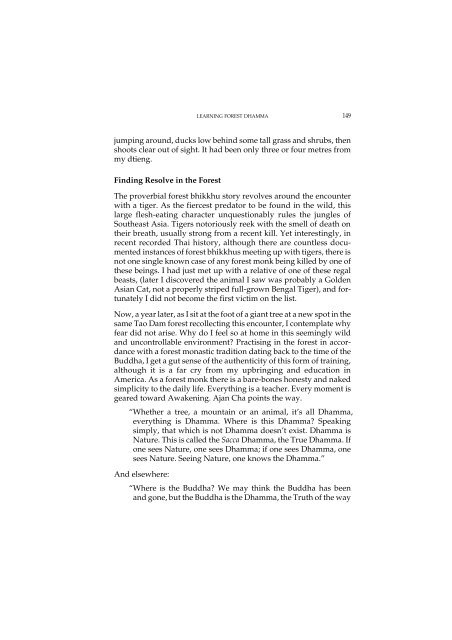Forest Path - Amaravati Buddhist Monastery
Forest Path - Amaravati Buddhist Monastery
Forest Path - Amaravati Buddhist Monastery
You also want an ePaper? Increase the reach of your titles
YUMPU automatically turns print PDFs into web optimized ePapers that Google loves.
learning forest dhamma 149<br />
jumping around, ducks low behind some tall grass and shrubs, then<br />
shoots clear out of sight. It had been only three or four metres from<br />
my dtieng.<br />
Finding Resolve in the <strong>Forest</strong><br />
The proverbial forest bhikkhu story revolves around the encounter<br />
with a tiger. As the fiercest predator to be found in the wild, this<br />
large flesh-eating character unquestionably rules the jungles of<br />
Southeast Asia. Tigers notoriously reek with the smell of death on<br />
their breath, usually strong from a recent kill. Yet interestingly, in<br />
recent recorded Thai history, although there are countless documented<br />
instances of forest bhikkhus meeting up with tigers, there is<br />
not one single known case of any forest monk being killed by one of<br />
these beings. I had just met up with a relative of one of these regal<br />
beasts, (later I discovered the animal I saw was probably a Golden<br />
Asian Cat, not a properly striped full-grown Bengal Tiger), and fortunately<br />
I did not become the first victim on the list.<br />
Now, a year later, as I sit at the foot of a giant tree at a new spot in the<br />
same Tao Dam forest recollecting this encounter, I contemplate why<br />
fear did not arise. Why do I feel so at home in this seemingly wild<br />
and uncontrollable environment? Practising in the forest in accordance<br />
with a forest monastic tradition dating back to the time of the<br />
Buddha, I get a gut sense of the authenticity of this form of training,<br />
although it is a far cry from my upbringing and education in<br />
America. As a forest monk there is a bare-bones honesty and naked<br />
simplicity to the daily life. Everything is a teacher. Every moment is<br />
geared toward Awakening. Ajan Cha points the way.<br />
“Whether a tree, a mountain or an animal, it’s all Dhamma,<br />
everything is Dhamma. Where is this Dhamma? Speaking<br />
simply, that which is not Dhamma doesn’t exist. Dhamma is<br />
Nature. This is called the Sacca Dhamma, the True Dhamma. If<br />
one sees Nature, one sees Dhamma; if one sees Dhamma, one<br />
sees Nature. Seeing Nature, one knows the Dhamma.”<br />
And elsewhere:<br />
“Where is the Buddha? We may think the Buddha has been<br />
and gone, but the Buddha is the Dhamma, the Truth of the way

















